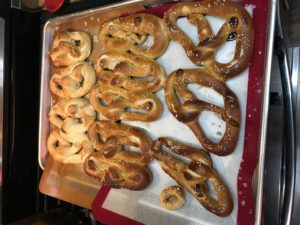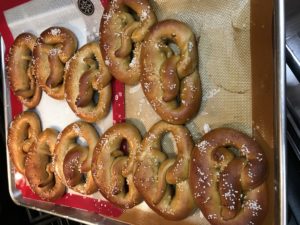Soft pretzels
Back history:
My first foray into soft pretzel making was with a Collective Kitchen class, from a baker who learned to make them actually in Bavaria. His recipe was similar to the NYT’s, below, but started with a pate fermentee, a bit of dough made in advance and allowed to sit overnight before being added to the rest of the dough. I learned a lot there, including how to shape Bavarian style pretzels (I learned how to shape Philadelphia-style ones on a Girl Scout trip years ago) and why pretzels need to include malt syrup and be dipped in lye. Thus, when I decided to try soft pretzels on my own, I looked for recipes with both the malt and the lye included. (Amazon sells both malt syrup and food-grade lye.) In the class, we made and shaped out own, but since the dough needs to sit and rise a while, the ones we actually dipped in lye, baked and ate were from a batch he’d previously prepared. Liking pretzels and not wanting to waste the dough, I brought my batch home. I didn’t have lye, so I dipped those in a baking soda solution, verifying that does work. I also learned through experiment that if you freeze pretzels, then wet them, apply salt, microwave 30 seconds then bake 5 minutes at 425, they reheat perfectly and taste fresh.
I’d also gotten to taste real Philadelphia pretzels again recently, thanks to an extremely thoughtful birthday gift from my friend Peg. (This turned out to be lucky, too, because they included enough extra real pretzel salt to use for both batches.
Recipe 1: Reluctant Gourmet “Best Soft Pretzels”
This recipe actually calls for a dip in baking soda, but I used lye since I had it. (1/2 cup to 10 cups of water, as recommended in the NYT recipe). It tells you to put the pretzels in the freezer to firm them up, but I have a side by side fridge that is too narrow for a cooking sheet, so I put them in the fridge for maybe 45 minutes instead. They stayed firm enough to be easy to handle in their lye bath. The recipe calls for an egg wash after the lye bath, but I skipped that; neither the recipe from my class nor the NYT used it, and I don’t think Philly pretzels have it (an egg wash is what produces that very firm glossy crust on Challah).
Recipe 2: New York Times Bavarian-style pretzels
The his made a very stiff dough; the mixer (Kitchen Aid Professional line, but the Costco version) had some trouble handling it and was sending up smoke, so I finished kneading by hand. Then I realized I’d screwed up and forgotten to add the malt syrup. I didn’t want to waste the batch, so I added it in and kneaded some more (it did soften the dough a bit). I was afraid that not feeding the yeast from the beginning wouldn’t let the dough rise enough, but thought it was better to experiment, because I didn’t want to start over. I let this batch sit in the refrigerator overnight; one result of this was that they did most of their rising there, while the other batch rose more in the oven.
Differences between recipes
The Reluctant Gourmet (henceforth, RG) recipe uses all purpose flour and regular yeast, whereas the NYT uses bread flour and instant yeast. This required some shopping because what I normally have on hand for my no-knead bread is all-purpose flour and instant yeast - I think I may try the remaining bread flour in my next batch of bread. Also, the Reluctant Gourmet recipe notes ingredients by weight, whereas the NYT uses volume (cups, tablespoons etc). As an American cook I find the latter easier because it’s what I’m used to, but the latter is supposed to be more precise. It was kind of fun, using the tare function and measuring ingredients on my scale.
Also, the RG recipe lets the dough rise as dough in a bowl, whereas the NYT recipe has the rising after the pretzels are shaped (as does the recipe from the class I took).
So that I’d be able to tell them apart, I shaped the RG recipe Philadelphia-style (long oblongs) and the NYT batch in traditional Bavarian shape.
Results:
Reluctant Gourmet

New York Times

NYT all the way. Though I wouldn’t kick the Reluctant Gourmet recipe out of bed for leaving pretzel crumbs! It was pretty good and would not garner complaints on a Philly pretzel cart, but the NYT recipe had just perfect texture and complex taste.
Adding the malt syrup later to the NYT batch doesn’t seem to have caused any issues - they rose just fine.
For some reason, 3 of the RG batch came out pale, as though they hadn’t been dipped in lye solution, even though I’m sure I dipped all of them. It still tasted like a pretzel, though - without the alkalizing bath, what you get is more like regular bread (I experimented on one of the batch from my class).
Conclusion and Lessons Learned:
The overnight rising for the NYT batch may have helped. I will be curious to try the NYT recipe again and see if adding the malt at the proper time makes any difference. (Who knows, maybe I’ve discovered something!)
Malt syrup is difficult to work with. I wish they’d packaged it in a squeeze bottle, like honey often has now, instead of a jar with a lid. It did help the taste and I may experiment with adding some to my bread.
One other important thing I learnersd is, do not make a batch of pretzels on Friday night after work! The problem with this is that lye is not a chemical you want to play around with. Even though it’s probably not a strong enough solution to do real harm, I wore rubber gloves and was careful with the solution. But between the active time and the rising time, it takes quite a while until you get to that part. This results in an unconscionably long delay before you can have a well-deserved glass of wine at the end of a long work week.
Mirrored from Dichroic Reflections.